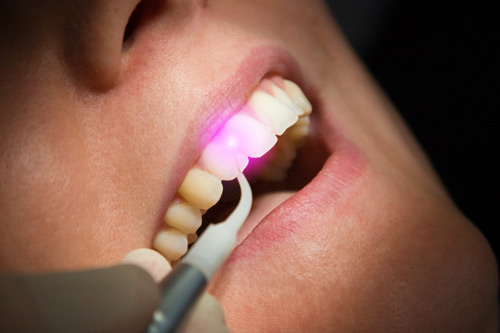Dental lasers are incredibly versatile and well-accepted by our patients. The following dental procedures can be performed with dental lasers:
Soft tissue recontouring – Excessive gum tissue can be virtually erased with a dental laser to reshape the gumline (crown lengthening for a gummy smile) or remove the tissue overgrowths that are common for denture wearers.
Frenectomy – The soft tissue ligaments that are found at the base of the tongue and insides of the lips can be removed with lasers to reduce the degree of strain on the surrounding tissues.
Tumor removal – Benign tumors related to the soft tissues of the mouth can be completely and painlessly removed with a dental laser.
Biopsy – Lasers provide enough precision to remove small portions of soft tissue for a more conservative and more comfortable biopsy procedure.

The type of laser that is recommended for your gum treatment may be influenced by the type of procedure that has been planned for you. There are different types of dental lasers, and some are specially adapted for certain conditions. These lasers function at different wavelengths for different uses. The carbon diode and carbon dioxide lasers are most commonly employed for soft tissue treatments involving the gums, lips, tongue, and cheeks.
To determine which laser gum treatment is right for you, we will first conduct a detailed and personalized periodontal evaluation to learn about your needs. If you would like to learn more about the use of lasers in periodontics, please contact our office to schedule your consultation today.
With laser gum treatment, a periodontist uses lasers to excise tissue rather than the traditional method of scalpels and sutures. This method is more conservative and precise, allowing the periodontist to remove only the questionable tissue and leave surrounding healthy tissue largely untouched.
Additionally, lasers cause less discomfort so the patient will need less anesthesia. Most patients can undergo laser gum treatment with just a local anesthetic. These lasers can be used in a variety of treatment scenarios, including gum contouring and removal of growths in the gum tissue for biopsy.
Patients with persistent periodontal disease are plagued by the buildup of oral bacteria, which can occur even if they have received conventional treatment for the condition previously. Bacteria can enter the bloodstream during a standard dental cleaning, but initial treatment with lasers along the gumline to reduce the quantity of oral bacteria can limit this possibility. Laser bacterial reduction is quick and typically painless, and it can be very effective in boosting the health of your gum tissue and your smile in general.


